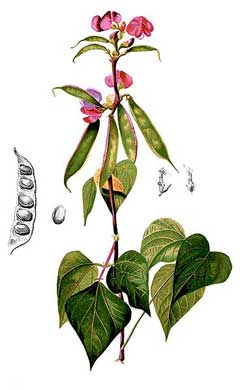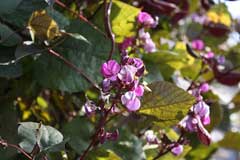 |
|
http://commons.wikimedia.org/wiki/File:Lablab_purpureus_Blanco2.292-cropped.jpg |
 |
| http://commons.wikimedia.org/wiki/User:Dalgial |
Translate this page:
Summary
Bloom Color: Pink. Main Bloom Time: Early summer, Early fall, Late summer, Mid summer. Form: Spreading or horizontal.
Physical Characteristics

 Lablab is a PERENNIAL CLIMBER growing to 2 m (6ft 7in) at a fast rate.
Lablab is a PERENNIAL CLIMBER growing to 2 m (6ft 7in) at a fast rate.
See above for USDA hardiness. It is hardy to UK zone 10 and is frost tender. It is in flower from July to September, and the seeds ripen from September to October. The species is hermaphrodite (has both male and female organs) and is pollinated by Insects.
It can fix Nitrogen.
Suitable for: light (sandy), medium (loamy) and heavy (clay) soils and prefers well-drained soil. Suitable pH: mildly acid, neutral and basic (mildly alkaline) soils. It cannot grow in the shade. It prefers moist soil and can tolerate drought.
UK Hardiness Map
US Hardiness Map
Synonyms
L. vulgaris. Dolichos lablab. L.
Plant Habitats
Edible Uses
The mature seed is edible as long as it is thoroughly cooked[2, 27, 33, 34, 74, 171]. It has a mild flavour, is rich in protein and can be used as a staple food. The seed can also be prepared as 'tofu' or be fermented into 'tempeh' in the same way that soya beans are used in Japan[183]. The seed can also be sprouted and eaten raw, when it is comparable to mung bean sprouts[179, 183]. A nutritional analysis is available[218]. The tender young seedpods and immature seeds can be eaten raw or cooked. They can be used as a green vegetable like French beans[46, 74, 114]. They are also used as a curry vegetable[183]. The immature seedpod contains 3.2% protein, 0.8% fat, 5.4% carbohydrate, 0.81% ash. It is rich in vitamin B1[179]. Leaves - they must be cooked[160, 179]. They can also be dried for later use[183]. The leaves are used as a greens just like spinach[183]. They contain up to 28% protein[160] (dry weight?). Flowers - raw or cooked in soups and stews[183]. Root - large and starchy[183].
References More on Edible Uses
| Composition
|
| Figures in grams (g) or miligrams (mg) per 100g of food.
|
|
|
Seed (Fresh weight)
|
|
- 334 Calories per 100g
- Water : 12.1%
- Protein: 21.5g; Fat: 1.2g; Carbohydrate: 61.4g; Fibre: 6.8g; Ash: 3.8g;
- Minerals - Calcium: 98mg; Phosphorus: 345mg; Iron: 3.9mg; Magnesium: 0mg; Sodium: 0mg; Potassium: 0mg; Zinc: 0mg;
- Vitamins - A: 0mg; Thiamine (B1): 0mg; Riboflavin (B2): 0mg; Niacin: 0mg; B6: 0mg; C: 0mg;
- Reference: [ 218]
- Notes:
|
|
Medicinal Uses
Plants For A Future can not take any responsibility for any adverse effects from the use of plants. Always seek advice from a professional before using a plant medicinally.
The plant (though the exact part used is not stipulated) is anticholesterolemic, antidote (to most forms of poison), antivinous, carminative, hypoglycaemic. Prolongs co-agulation time[147, 176, 178]. It is used in the treatment of cholera, vomiting, diarrhoea, leucorrhoea, gonorrhoea, alcoholic intoxication and globefish poisoning[147]. The flowers are antivinous, alexiteric and carminative[218]. The stem is used in the treatment of cholera[218]. The juice from the pods is used to treat inflamed ears and throats[218]. The fully mature seeds are anthelmintic, antispasmodic, aphrodisiac, astringent, digestive, febrifuge and stomachic[218, 240, 283]. They are used in the treatment of sunstroke, nausea, vomiting, diarrhoea, enteritis, abdominal pain, alcoholism and arsenism[283]. The seed is well dried and then roasted before use[283].
References More on Medicinal Uses
The Bookshop: Edible Plant Books
Our Latest books on Perennial Plants For Food Forests and Permaculture Gardens in paperback or digital formats.

Edible Tropical Plants
Food Forest Plants for Hotter Conditions: 250+ Plants For Tropical Food Forests & Permaculture Gardens.
More

Edible Temperate Plants
Plants for Your Food Forest: 500 Plants for Temperate Food Forests & Permaculture Gardens.
More

More Books
PFAF have eight books available in paperback and digital formats. Browse the shop for more information.
Shop Now
Other Uses
Plants are fairly fast growing and the bacteria on the roots enrich the soil with nitrogen. This makes them a good green manure crop, though they are only really suitable for climates warmer than Britain[46, 61].
Special Uses
References More on Other Uses
Cultivation details
Landscape Uses:Arbor, Container. Easily grown in an ordinary garden soil so long as the temperature is sufficient[1]. Succeeds in relatively poor soils so long as they are well-drained[206]. Plants grow best at temperatures between 28 - 30°c though they tolerate mean temperatures as low as 9°c[206]. Prefers a rich moist soil in a warm sheltered position[175]. Prefers a well-drained soil with a high organic matter content and a pH between 5.5 and 6[200]. Some varieties are drought resistant[200]. A perennial species[142], it is not cold-hardy in Britain, though it is occasionally grown as an annual in the ornamental garden[27, 33]. It requires a minimum temperature of 7 - 10°c if it is to survive winter conditions[200]. The hyacinth bean is commonly cultivated in warm temperate and tropical climates for its edible seed, there are many named varieties[183, 200] varying in height from 60cm to 2 metres. Short-day, long-day and daylength-neutral varieties are available, you should use day-length-neutral or long-day varieties in northern latitudes[200]. Plants are fairly fast-growing, young pods are ready to harvest from 70 - 120 days after sowing[200]. This species has a symbiotic relationship with certain soil bacteria, these bacteria form nodules on the roots and fix atmospheric nitrogen. Some of this nitrogen is utilized by the growing plant but some can also be used by other plants growing nearby[200]. Special Features:Edible, Fragrant flowers.
References Carbon Farming Information and Carbon Sequestration Information
Temperature Converter
Type a value in the Celsius field to convert the value to Fahrenheit:
Fahrenheit:
The PFAF Bookshop
Plants For A Future have a number of books available in paperback and digital form. Book titles include Edible Plants, Edible Perennials, Edible Trees,Edible Shrubs, Woodland Gardening, and Temperate Food Forest Plants. Our new book is Food Forest Plants For Hotter Conditions (Tropical and Sub-Tropical).
Shop Now
Plant Propagation
Seed - pre-soak for 2 hours in warm water and sow in early spring in a greenhouse in a fairly rich soil[33, 175]. Either sow 2 seeds to a pot and thin to the strongest plant, or sow in a tray and prick out into individual pots when the plants are large enough to handle. Grow on fast and plant out after the last expected frosts. The seed germinates in 2 - 4 weeks at 25°c.
Other Names
If available other names are mentioned here
Native Plant Search
Search over 900 plants ideal for food forests and permaculture gardens. Filter to search native plants to your area. The plants selected are the plants in our book 'Plants For Your Food Forest: 500 Plants for Temperate Food Forests and Permaculture Gardens, as well as plants chosen for our forthcoming related books for Tropical/Hot Wet Climates and Mediterranean/Hot Dry Climates. Native Plant Search
Found In
Countries where the plant has been found are listed here if the information is available
Weed Potential
Right plant wrong place. We are currently updating this section.
Please note that a plant may be invasive in one area but may not in your area so it’s worth checking.
Conservation Status
IUCN Red List of Threatened Plants Status :

Growth: S = slow M = medium F = fast. Soil: L = light (sandy) M = medium H = heavy (clay). pH: A = acid N = neutral B = basic (alkaline). Shade: F = full shade S = semi-shade N = no shade. Moisture: D = dry M = Moist We = wet Wa = water.

Expert comment
Author
(L.)Sweet.
Botanical References
200
Links / References
For a list of references used on this page please go here
Readers comment
| Add a comment |
|
If you have important information about this plant that may help other users please add a comment or link below. Only comments or links that are felt to be directly relevant to a plant will be included. If you think a comment/link or information contained on this page is inaccurate or misleading we would welcome your feedback at [email protected]. If you have questions about a plant please use the Forum on this website as we do not have the resources to answer questions ourselves.
* Please note: the comments by website users are not necessarily those held by PFAF and may give misleading or inaccurate information.
To leave a comment please Register or login here All comments need to be approved so will not appear immediately.
|
|